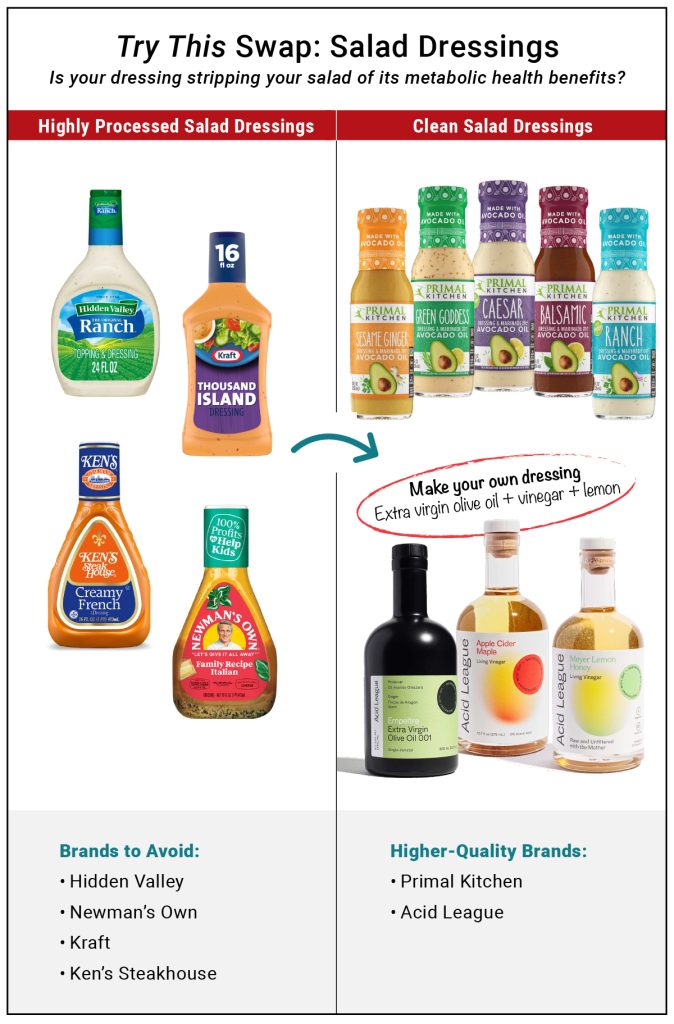
Today we’re talking about the problem ingredients found in most conventional salad dressings and some of my favorite alternatives that can add to your salad’s nutritional content—not take away from it.

Creating an environment that supports optimal quality sleep is super important to me. My bed sheets are a critical part of that process, and nobody does bed sheets better than Cozy Earth.
Cozy Earth’s bed sheets are the softest sheets I’ve ever slept on, free from toxic chemicals, and help keep me cool at night with their ultra-breathable viscose from bamboo fabric.
There’s a reason why Cozy Earth bed sheets have made Oprah’s list of favorite things five years in a row. They’re simply the best, and now they come in seven different colors to match any bedroom style.
If you’re looking to optimize your sleep environment even further, now’s the time. Rest your head on one of Cozy Earth’s silk pillowcases for next-level comfort.
Right now, Cozy Earth is offering my community 40% off their bed sheets and silk pillows. And for a limited time, this offer applies to their ultra-soft and durable Waffle Bath Towels, too!

Let’s jump in!
Be on the Lookout for These Problem Ingredients
It’s our responsibility to become food detectives, which means we have to get in the habit of reading ingredient labels and knowing what problem ingredients to look for before dropping an item into our cart. When picking out a salad dressing, do your best to avoid these red flags.
- Vegetable-seed oils. Vegetable oils are ubiquitous in processed and packaged foods, and salad dressings are no exception! Even well-known brands that are thought to be healthier options often contain cheap, inflammatory oils that cause metabolic dysfunction in the body. Here are the ones most commonly found in salad dressings:
- Canola oil
- Soybean oil
- Cottonseed oil
- Sunflower oil
- Safflower oil
- Added sugar. It is not uncommon for salad dressings to contain some form of added sugar, typically high fructose corn syrup or cane sugar. In my opinion, sugar in salad dressings is a little counterintuitive because it takes away from its metabolic benefits.
- Preservatives. Preservatives such as sodium benzoate, potassium sorbate, titanium dioxide, and EDTA are added to salad dressing to prevent spoilage and extend their shelf life. Not much is known about the long-term effects of consuming food additives on a regular basis, so it’s best to err on the side of caution and minimize your intake wherever possible.
- Food coloring. Ever wonder how that bottle of French dressing gets that bright orange color? That’s food coloring, folks. We’ve talked about the dangers of artificial dyes for children’s brains, and they’re super common in salad dressings. Red 40, yellow 5, and yellow 6 are the ones you’ll typically find on the label.
- Gums and emulsifiers. Emulsifiers help keep the oil, water, and vinegar blended and homogenous in the bottle. Although technically considered safe for consumption, they can trigger gut issues and bloat in sensitive people. Of the gums in conventional salad dressings, carrageenan is the most concerning for its potential link to colon cancer.
- Flavor enhancers. A food additive known as monosodium glutamate (MSG) is often used to make processed food ultra-palatable…and, dare I say, hella addicting. MSG goes by many different names on salad dressing ingredient labels (e.g., hydrolyzed corn and soy protein, autolyzed yeast extract, l-glutamic acid, and monohydrate) and can cause migraines, flushing, and inflammation in some people.
Try This:
Luckily, there are some salad dressing brands out there that don’t suck. Here are a few of my favorites:
- Primal Kitchen Salad Dressings. I like Primal Kitchen because they use avocado and extra virgin olive oil instead of cheap vegetable-seed oils. They’re also one of the first to make clean, high-quality pantry staples more accessible to the public. Many Primal Kitchen dressings contain organic guar gum and acacia gum. These gums are classified as prebiotic fiber and may actually have a positive effect on our health in small doses. However, if you have IBS or gut issues, it’s best to avoid these while you’re getting your gut health back on track.
- Acid League Meyer Lemon Honey. I recently came across this salad dressing and loved it. Acid League’s Meyer Lemon Honey dressing is made from raw, unfiltered vinegar and lemon juice and sweetened with a touch of honey. Their Apple Cider Maple flavor is another excellent option for a lighter dressing. It contains no oils and only two grams of sugar per serving.Quick note: I am not affiliated with the brands mentioned above. I simply love their products. My goal with Try This is not to promote specific brands but to share the products I believe in that have made a difference in my life. Any time I am affiliated with a product, I will let you know with radical transparency.
- Make your own dressing. Making your own salad dressing is the best way to ensure you’re using the highest-quality ingredients without any fillers or preservatives. Extra virgin olive oil and lemon juice (or your favorite vinegar) is a classic, healthy option. But if you’re looking for a little extra pizzazz, my co-writer Taylor has an awesome tahini-based salad dressing recipe you can check out here.
Final Thoughts
A big, fat salad is one of the best ways to incorporate more plants into your diet (which means more gut and immune-supporting polyphenols!).
Dressing is an important piece that makes a salad taste great, but it can easily take away from its health benefits if it contains any of the troublesome ingredients mentioned above.
I hope this newsletter encourages you to take a second look at your salad dressing label and to search for brands with cleaner ingredients (or make your own!) that will support your health and make your salad taste great!
Here’s to your health,
Dhru Purohit